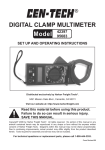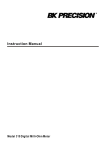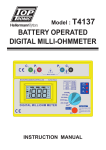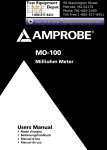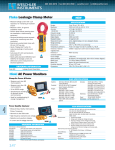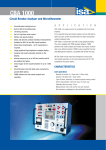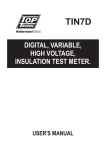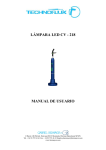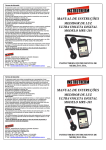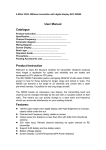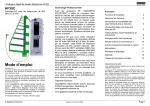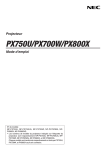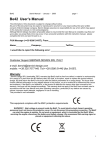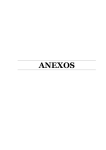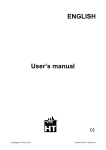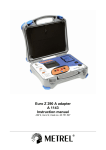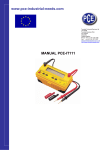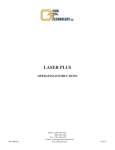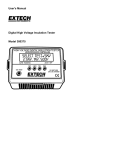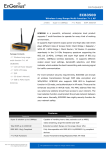Download TEST Start/Stop
Transcript
E S T N R G O IE P S DIGITAL LOW RESISTANCE OHM and CONTACT METER 15VAC or 17VDC BATTERY CHARGER DIGITAL LOW RESISTANCE OHM and CONTACT METER MICROPROCESSOR CONTROLLED RC C1 + P1 P2 C2 AC DC 100mA 2000mW OFF MAX MIN P1 mV kMW C1 P1 Start/Stop P2 C2 I ON TEST C2 3T C1 P1 + V 2T SCROLL RANGE P2 + V VDC / 4T 3T / 2T 10mA 200.0W C2 I Hz kA ms P2 + V 4T MANUAL RANGING HOLD CONNECTIONS C1 RP 1A 20.00mW RANGE CF MEASUREMENT ICCS OFF 100mA 20.00W FUSE PF CROWBAR FUSES 1A 2.000mW 1A 200.0mW FUSE I INSTRUCTION MANUAL Description Page SAFETY RULES ...................................................... 03 SAFETY CHECK ..................................................... 04 DON'T TOUCH ........................................................ 04 GENERAL DESCRIPTION ...................................... 05-06 OPERATING INSTRUCTIONS ................................ 07-10 DISPLAY .................................................................. 11 SPECIFICATIONS ................................................... 12-13 CLEANING .............................................................. 13 INSIDE LID INSTRUCTIONS LABEL ...................... 14 CONNECTION METHOD(4 WIRE TEST) .............. 15 CONNECTION METHOD(3 WIRE TEST) ............... 16 CONNECTION METHOD(2 WIRE TEST) ............... 17 TYPICAL APPLICATIONS ....................................... 18-19 WORKING PRINCIPLE OF THE INSTRUMENT...... 20 CHARGING THE BATTERY .................................... 21 FUSE REPLACEMENT ........................................... 22 NOTES .................................................................... 23 LIMITED WARRANTY ............................................. 24 SAFETY RULES CAUTION RISK OF ELECTRIC SHOCK This tester has been designed with your safety in mind. However, no design can completely protect against incorrect use. Electrical circuits can be dangerous and/or lethal when lack of caution or poor safety practices are used. Do not carry out field measurements on either the power system grounding or anything connected to it, without ensuring the contact or circuit under test is fully isolated. Take all the necessary precautions. Do not exceed the limits of this instrument. The circuit to be tested must be de-energised and isolated before connections are made to it. Do not use test leads, probes or crocodiles/aligators clips that are dirty, damaged or have broken or cracked insulation. Such accessories should be removed and repaired Immediately. Always disconnect the test leads before replacing any fuse. Always replace the fuse with the type specified and ensure that they are correctly fitted. Double check your settings and leads connections before measuring. Make a sketch to ensure proper operation and the principle of measurement is correct and well understood. Do not touch any exposed wiring, connections or other "live" parts of an electrical circuit. If in doubt, check the circuit for no voltage first before testing it. Disconnect the tester from any external circuit when charging the battery. CAUTION READ THE MANUAL Follow the instructions in the Manual for every measurement. Read and understand the general instructions before attempting to use this tester. -3- SAFETY CHECK Before using the tester check the condition of the battery. This is done by switching the tester ON. If the BAT LOW symbol appears the battery needs charging. When charging the battery, changing a fuse, or removing the cover to access the internal circuitry, always disconnect the test leads. When replacing the fuse use only the type specified, and insert correctly in the fuse holder. Double check the settings, and lead connections before making measurements. DON'T TOUCH Don't touch exposed wiring, connections or other "Live" parts of an electrical circuit. If in doubt, check the circuit first for voltage before touching or connecting to it. Do not use cracked of broken test leads. THIS INSTRUMENT SHOULD ONLY BE USED BY A COMPETENT, SUITABLY TRAINED PERSON. REMEMBER SAFETY IS NO ACCIDENT CAUTION RISK OF ELECTRIC SHOCK CAUTION READ THE MANUAL -4- GENERAL DESCRIPTION The Digital Low Resistance Ohm and Contact Meter is a battery (rechargeable) operated instrument which supplies a constant current to the circuit under test, with which is stable for accurate measurements of very low resistance (down a micro ohm) over a wide range of values. Resolution on the lowest range is 1µohm and on the highest range, 100 milli-ohm. The meter has 6 measuring ranges, from 2000 micro-ohm to 200.0 ohms. Measurements are displayed on a large 3½ digit custom liquid crystal display. This instrument is powered from it's internal rechargeable battery. It has a regulated DC constant current source with current of 10mA 100mA and 1A. When recharging the battery, the instrument is disconnected from the battery. Measurements can only be made while not charging. The instrument supplies the current to the resistance being measured through the C1 and C2 terminals (C1 being +, C2 being -). The voltage drop across the resistance under test is measured by the potential terminals P1 and P2 (P1 being +, P2 being -). Should the current regulation fall out, the RC LED will indicate, that the resistance in the current circuit is too high. (Lowering the current by selecting a higher resistance range can solve the regulation.) Should the RP LED light up, it mean that the voltage measured on the resistance is too high, and therefore over-range. (Lowering the current by selecting a higher resistance range can solve the over voltage on RP.) The resistance can only be measured precisely when the RP and RC LEDs are not lit. If any of these LEDs lights up, then the measurement will be inaccurate. -5- The ICCS LED indicates the Constant Current Source is OFF. When this LED lights up, it means that the current injection has been switched OFF (eg could be over-temperature). The meter has a built-in custom 3½ digit liquid crystal display which can be viewed in most lighting conditions. This display indicates the conditions (Hold, m, buzzer, polarity condition of load, + or -, automatic decimal point change with range selection). The ranges are selected by the "SCROLL / RANGE" push button. A test is initiated by pressing the TEST/STOP push-button. The instrument takes measurements for 10 seconds if the TEST/STOP push-button is depressed for less than 3 seconds (EnerSave mode). If the TEST/STOP push button is depressed for more than 3 seconds, the test will carry on for 60 seconds. The tester switches OFF completely when the "OFF" push button is pressed, but the meter has also an auto-off feature The tester "Hold" the last reading before stopping the test. The tester is fuse protected and has a crowbar between C1 and C2. This crowbar is activated by voltage. If the voltage is too high, that crowbar will blow the CF fuse automatically to interrupt the circuit. The voltage between P1 and P2 is also protected for over voltage .If that voltage is too high, the crowbar will blow the PF fuse automatically to interrupt the circuit. The tester has a temperature shut down. The temperature sensing is done on the current regulation transistor. Should this over-temperature alarm be activated, the ICCS OFF LED will light, indicating the current has been shut down. Allow the instrument to cool down for a while before proceeding further. -6- OPERATING INSTRUCTIONS BATTERY CHARGER 15VAC or 17VDC ON OFF SCROLL RANGE . The connector for the Battery charger can accept AC or DC signals up to a maximum of 22Vdc. There is a full bridge rectifier inside the tester, as well as a regulated battery charger. The battery is charged to 13.8V. We recommend the use of the power supply (step down transformer) which is supplied with this tester. The light on the power supply transformer lights up when the battery charger is working. Depressing the ON key will switch the tester "ON" . At switch "ON", the tester retrieves the last settings utilized. These are the current/range settings which were last utilized by the Instrument. At Switch ON, the buzzer sounds to confirm the "ON" status Depressing the OFF key will switch the instrument "OFF". This "OFF" switch is software operated. At switch OFF, the buzzer will sound to confirm the "OFF" condition is processed by the micro. Next, the tester will be switched OFF completely. Depressing the SCROLL/RANGE key will stop the test. The test is in progress, then the scroll will change to the higher ohms range. Depressing the key again will move the setting to the next range. Each range will indicate its corresponding LED -7- TEST Start/Stop 1A 2.000mW 1A 20.00mW Provided, the TESTER is ON, when the TEST Start/Stop is depressed, the selected TEST will start (if stopped) or stop (if in progress). The TEST Start/Stop also has the EnerSave features. What that means, is that if you depress the TEST Start/Stop key for more than 3 second, while starting the test, then, the test will be carried up to a duration of 1 minute (long Test). If you depress the TEST Start/Stop Key for less than 3 second, or just depress it, than the instrument will enter the EnerSave mode, and the test duration is limited to about 10 seconds. In both cases, the Test is stopped automatically by the instrument, but the user can always override the autostop, by depressing the TEST Start/Stop key at any time, in any mode. Range Indication by LED Test Current 1A Resistance 0-2.000mW (2000uW) When this LED lights up, the instrument will measure up to 1999uW and will display it as milli ohms. The resistance which can be measured using this scale/range is from 0.000m to 1.999m Ohm. Range Indication by LED Test Current 1A Resistance 0-20.00mW When this LED lights up, the instrument will measure up to 19.99mW and will display it as milli ohms. The resistance which can be measured using this scale/range is from 00.00m to 19.99m Ohm. -8- 1A 200.0mW 100mA 2000mW 100mA 20.00W 10mA 200.0W Range Indication by LED Test Current 1A Resistance 0-200.0mW When this LED lights up, the instrument will measure up to 199.9mW and will display it as milli ohms. The resistance which can be measured using this scale/range is from 000.0m to 199.9m Ohm. Range Indication by LED Test Current 100mA Resistance 0-2000mW When this LED lights up, the instrument will measure up to 1999mW and will display it as milli ohms. The resistance which can be measured using this scale/range is from 0000m to 1999m Ohm. Range Indication by LED Test Current 100mA Resistance 0-20.00W When this LED lights up, the instrument will measure up to 19.99W and will display it as ohms. The resistance which can be measured using this scale/range is from 00.00 to 19.99 Ohm. Range Indication by LED Test Current 10mA Resistance 0-200.0W When this LED lights up, the instrument will measure up to 199.9W and will display it as ohms. The resistance which can be measured using this scale/range is from 000.0 to 199.9 Ohm. -9- ICCS OFF RC RP Main Status Indicators ICCS OFF RC RP Constant Current Source Indicator. When this LED lights up, the Constant Current Source is shut down. The Constant Current Source is shut down when the test is not in progress. While in progress, the Constant current Source LED does not light up. After Switching the Instrument ON, the ICCS OFF led will lights up. When a test has stopped, the ICCS OFF LED lights up. In case of Over-Temperature, the ICCS OFF led will lights up. The RC indicator LED lights up, when the resistance between the current terminals is too high for the constant current source to regulate. This indicator is only significant while the test is in progress. You can try to lower the test curent if it comes on while testing. The RP indicator LED lights up, when the potential between the potential terminals is too high. This also can be due to the resistance under test being too high for that current range. Try to lower the current or increase the resistance range.(only significant while the test is progress). -10- DISPLAY HOLD M W HOLD The HOLD Sign indicator comes on when the readings are held. This happen At switch "ON", as no reading has been done yet, so the display is on Hold with whatever value when TEST stops. When Scroll/Range is depressed while a test is in progress. The Sound Sign indicator is shown while the buzzer is working. That means that when the Buzzer sounds, the sign is ON The Low Battery Sign indicator is showing when the battery need charging. The negative sign is shown when the test leads are reversed. This instrument is calibrated while the Test leads are in the correct polarity. -11- SPECIFICATIONS ELECTRICAL Resistance Ranges Range 0 to 2.000mW in steps of 0.000001W 0 to 20.00mW in steps of 0.00001W 0 to 200.0mW in steps of 0.0001W 0 to 2000mW in steps of 0.001W 0 to 20.00W in steps of 0.01W 0 to 200.0W in steps of 0.1W Accuracy 0 to 2.000mW => 0 to 20.00mW => 0 to 200.0mW => 0 to 2000mW => 0 to 20.00W => 0 to 200.0W => Test Current 5% of full scale ±5 digits 4% of full scale ±4 digits 4% of full scale ±4 digits 3% of full scale ±4 digits 2% of full scale ±4 digits 2% of full scale ±4 digits 1A ±3%. 100mA ±2%. 10mA ±1.5%. Maximum Output Voltage 10V rms Response Time 1secs nominal Voltage Withstand 6V AC between any two terminals Battery Low Indication point 10V nominal MECHANICAL Size Material Weight (less carrying case) Display 330 x 260 x 160 mm Polycarbonate/ABS ± xxxxxx g (with battery) Custom Liquid Crystal ENVIRONMENTAL Operating temperature Range Storage Temperature -15 °C to + 55 °C -20 °C to + 70 °C -12- General Safety Battery 12 V rechargeable 12V 2.3AH Fuses 1 x 50mA ( Potential Fuse ) 1 x 2A(Current Fuse) Slow Blow, 250V type SPARES AND ACCESSORIES Test Leads Kit 4 Test Leads Kit 5 Fuses FTK4 FTK5 50mA 2A Battery Instruction Manual 12V Rechargeable CLEANING Clean the instrument case with an anti-static cleaner and wipe with dry cloth. -13- IN E S T G P R O The battery charger needs low voltage AC or DC to be connected to it's input (front panel connector). The internal battery Charger has it's own regulation and the incoming voltage does not need to be regulated. -14- SCROLL RANGE If testing is in progress while depressing SCROLL/RANGE, the Test will be stopped, The next time you will switch the instrument ON, this range will be automatically selected. If you use the selected range, the instrument will keep this information in memory. Depress the SCROLL / RANGE button to change the range. RP RC This LED indicates that the Potential Circuit Voltage is TOO high. This LED indicates that the resistance in the Current Circuit is too high, or the current can't be regulated. This LED indicates that the current has been stopped (Constant Current ICCS OFF Source OFF). Switch the TEST ON or OFF. The TEST also auto-stop after 1 minute if EnerSave is disabled. Every time the TEST is stopped, the display is automatically HELD. If TEST depressed for less than 3 Sec. While starting a TEST, EnerSave is Enabled. When EnerSave is Enabled, TEST duration is reduced to around 10Sec. Start/Stop TEST RC1L C1 RP1L +P1 RX P2 RP2L C2 O M M ET M H EN O D D E EC RC2L R Resistance of Current Lead C1 Resistance of Potential Lead P1 Resistance of Potential Lead P2 Resistance of Current Lead C2 C1 RP1L +P1 RX P2 RP2L C2 RC2L C1 RP1L +P1 RX P2 C2 RP2L C2 & P2 SHORTED D Using the 2T method, the resistance of the test leads are added to the readings. This is not recommended for low resistance and long leads. 2T C1 & P1 SHORTED Using the 3T method, RC2L does not affect the readings. RP2L is negligeable as no current goes into and P2 but RP1L is added to RX. 3T C1 & P1 SHORTED Using the 4T method, RC1L, RC2L does not affect the readings RP1L and RP2L are negligeable as no current goes into P1 and P2. 4T RC1L = RP1L = RP2L = RC2L = FUSES: Both fuses (PF = Potential Circuit Fuse; CF = Current Circuit Fuse) are automatically blown if the corresponding crowbar has fired. The fuses must only be replaced by the same type of the same specification PF = 50mA; CF = 2A slow bow. RANGE 10mA 200.0W 100mA 20.00W 100mA 2000mW 1A 200.0mW 1A 20.00mW 1A 2.000mW WHEN THE INTERNAL BATTERY HAS REACHED IT’S END OF LIFE, ONLY REPLACE IT WITH THE SAME TYPE 15VAC or 17VDC BATTERY CHARGER THE INSTRUMENT IS DISABLED WHILE CHARGING. DISCONNECT BATTERY CHARGER TO OPERATE IT. INSIDE LID INSTRUCTION LABEL CONNECTION METHOD(4 WIRE TEST) C1 +P1 RC1L RP1L P2 RX C2 RP2L RC2L Using the 4T method, RC1L, RC2L does not affect the readings RP1L and RP2L are negligeable as no current goes into P1 and P2. For measuring low to very low resistance (eg contact resistance), this is the preferred measuring method because the resistance of the test leads does not have an effect (negligeable) on the measuring results. RC1L is the Resistance of the Current Lead going to C1 RC2L is the Resistance of the Current Lead going to C2 RP1L is the Resistance of the Current Lead going to P1 RP2L is the Resistance of the Current Lead going to P2 The input impedance between P1 & P2 is 10M ohms, so because the current being drawn by these pins is so small, the voltage loss on RP1L + RP2L is very small too. So the loss in these potential wires does not influence the voltage measured on P1 P2. The tester has a constant current source, the current flowing between C1 to C2 is stable and constant. Provided the resistance of the current leads are reasonably low (low enough for the current regulation to regulate properly), this method will give the best results compared to the following 2 methods. -15- CONNECTION METHOD(3 WIRE TEST) C1 +P1 RP1L P2 RX C2 RP2L RC2L Using the 3T method, RC2L does not affect the readings. RP2L is negligeable as no current goes into and P2 but RP1L is added to RX. For measuring low resistance, this measuring method can be utilized C1 and P1 terminals are shorted at the tester. RC2L is the Resistance of the Current Lead going to C2 RP1L is the Resistance of the Current Lead going to P1 RP2L is the Resistance of the Current Lead going to P2 In this case, RP1L is not negligeable anymore, because the current going into this lead is the constant current, which is high. So the error of RP1L exist and in reality, this error is added to Rx. So, if the resistance under test is much higher than the test lead, than, this method could be accepted. This method is a simplified method of measurement. Always, keep in mind, that RP1L is your error resistance. -16- CONNECTION METHOD(2 WIRE TEST) C1 +P1 RP1L P2 RX C2 RP2L Using the 2T method, the resistance of the test leads are added to the readings. This is not recommended for low resistance and long leads. For measuring resistance, this method can be utilized ie C1 and P1 terminals are shorted, P2 and C2 are shorted at the tester. RP1L is the Resistance of the Current Lead going to P1 RP2L is the Resistance of the Current Lead going to P2 In this case, RP1L and RP2L are not negligeable anymore, because the current going into these leads is the constant current, which is high. So an error with RP1L+ RP2L exists and this lead resistance error is added to Rx. So, if the resistance under test is much higher than the test leads, then, this method could be acceptable. This method is a simplified version of measurement. Always, keep in mind, that the lead resistances RP1Land RP2L are error measurements. This is not an accurate method and is not recommended, unless the resistance is above 10 ohms. -17- TYPICAL APPLICATIONS Measuring the contact resistance of circuit breakers. Measuring the bonding of welding points. Measuring the contact resistance of bolted conductors. Measuring the copper resistance fo transformers. -18- Measuring the earthing conductor resistance. Measuring the earth mat connections resistances. -19- WORKING PRINCIPLE OF THE INSTRUMENT -20- CHARGING THE BATTERY -21- FUSE REPLACEMENT REPLACING THE POTENTIAL FUSE REPLACING THE CURRENT FUSE -22- NOTES -23- LIMITED WARRANTY We warrant the product manufactured by us to be free from defective material or factory workmanship and agree to repair or replace this product which, under normal use and service, disclose the defect to be the fault of our manufacturing, with no charge for parts and service. If we are unable to repair or replace this product, we will make a full refund of the purchase price. Consult the user's manual for proper instruction regarding use of this instrument. Our obligation under this warranty is limited to repairing, replacing or making refund of this test equipment which proves to be defective within forty eight months from the date of original purchase. This warranty does not apply to any of our products which have been repaired or altered by unauthorized persons in any way so as, in our sole judgement, to injure their stability or reliability, or which have been subject to misuse, abuse, misapplication, negligence or accident or which have had the serial numbers altered, defaced or removed. Accessories, not of our manufacture used with this product, are not covered by this warranty. All warranties implied by law are hereby limited to a period of forty eight months, and the provisions of the warranty are expressly in lieu of any other warranties expressed or implied. The purchaser agrees to assume all liability for any damages or bodily injury which may result from the use or misuse of the product by the purchaser, or it's user, his employees, or others, and the remedies provided for in this warranty are expressly in lieu of any other liability we may have including incidental or consequential damages. We reserve the right to discontinue models at any time, or change specification, price or design, without notice and without incurring any obligation. -24F37
























